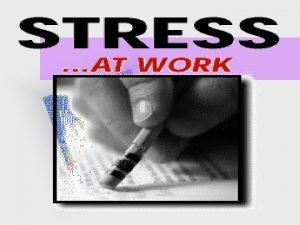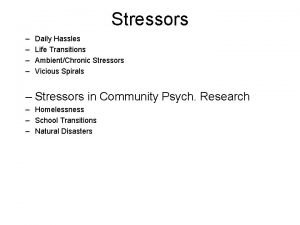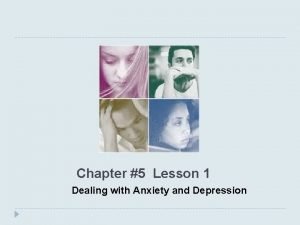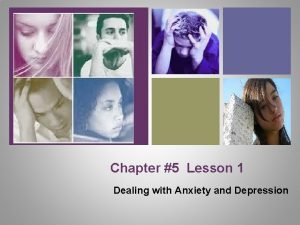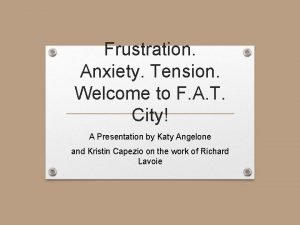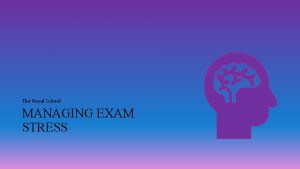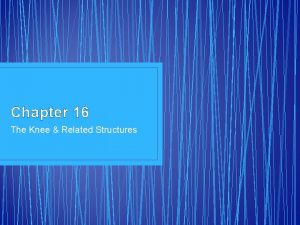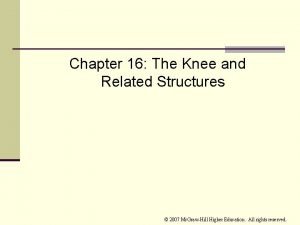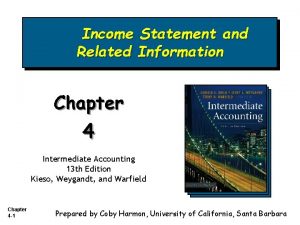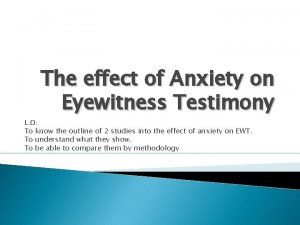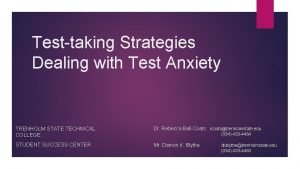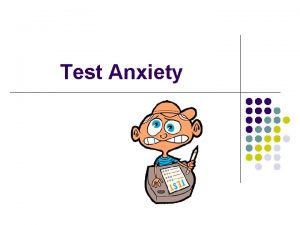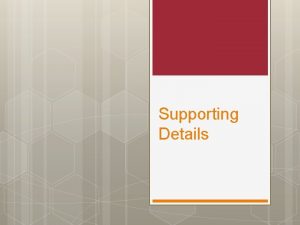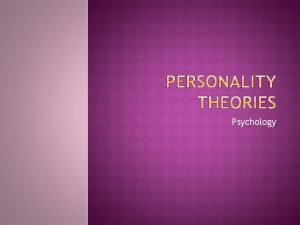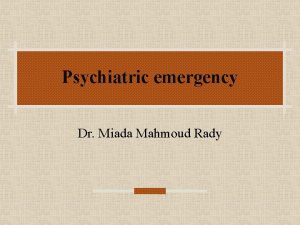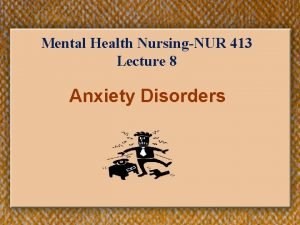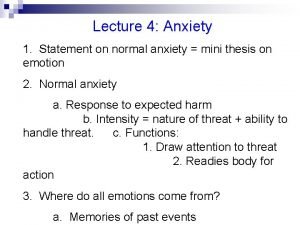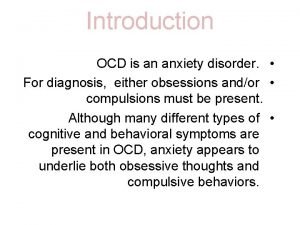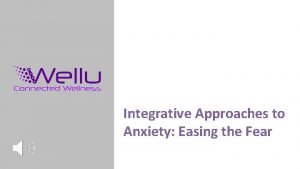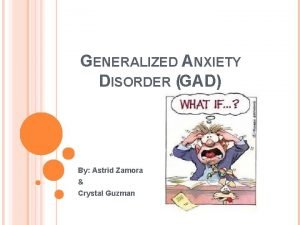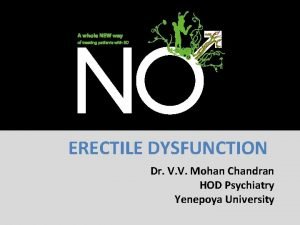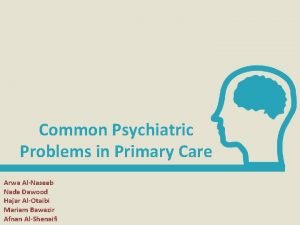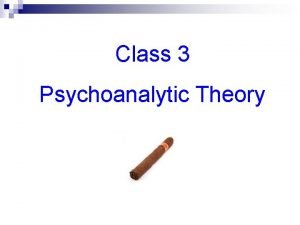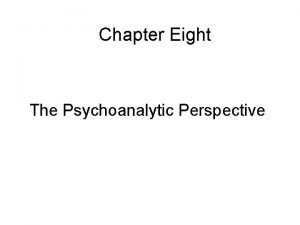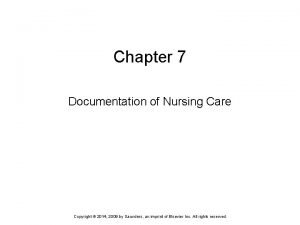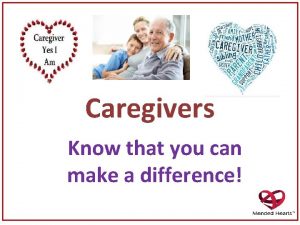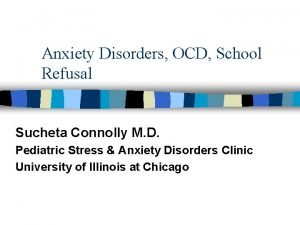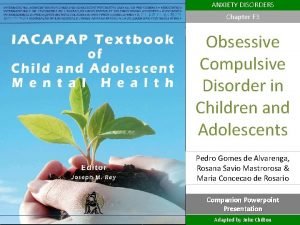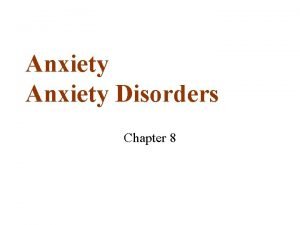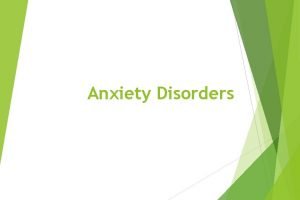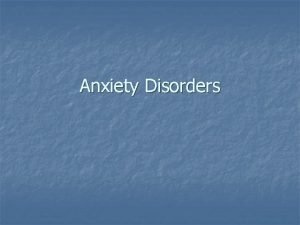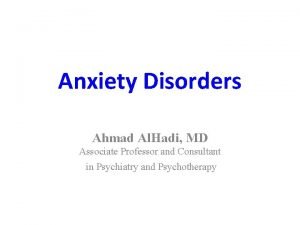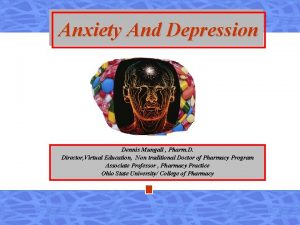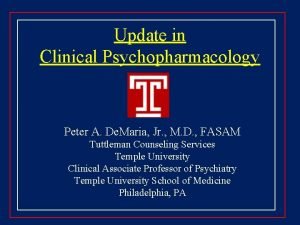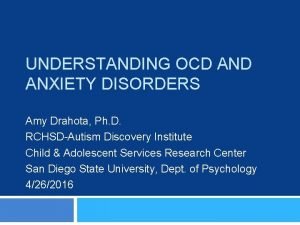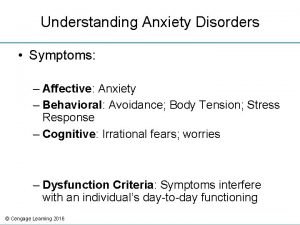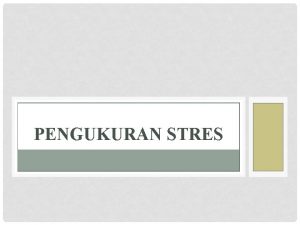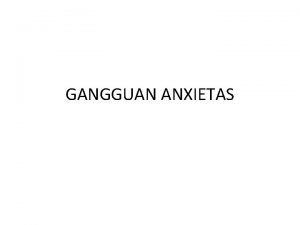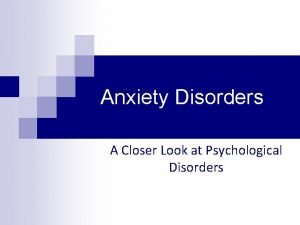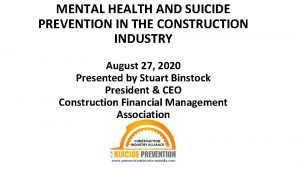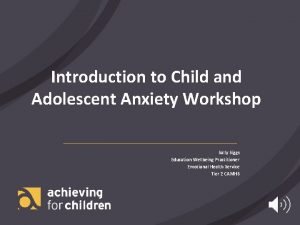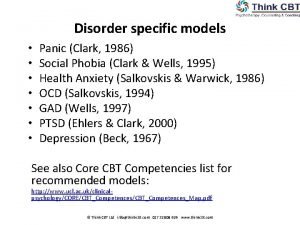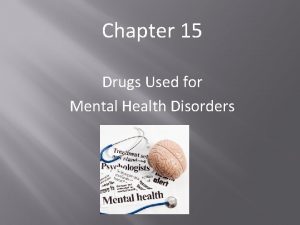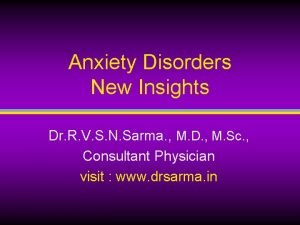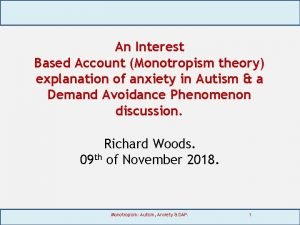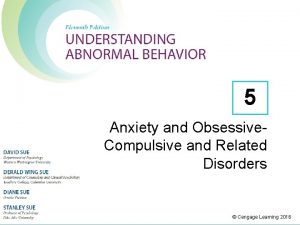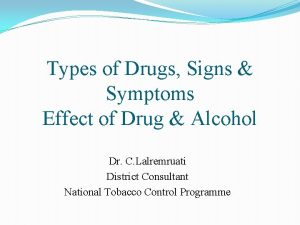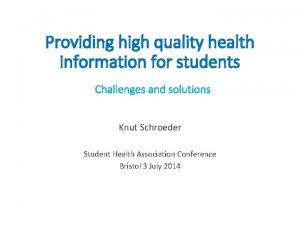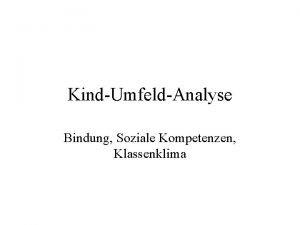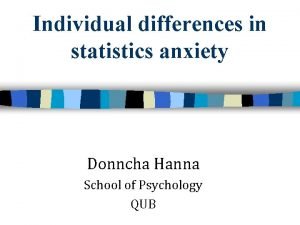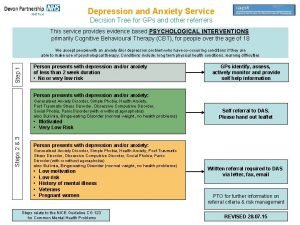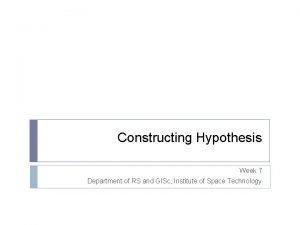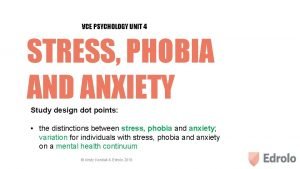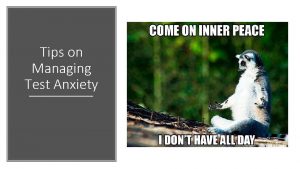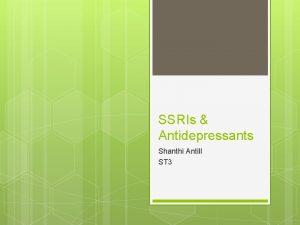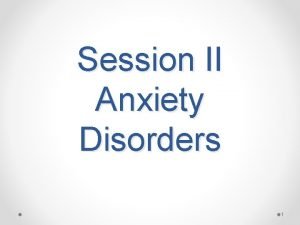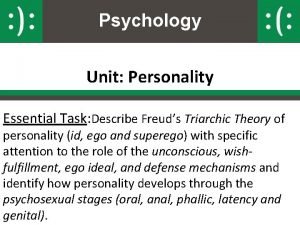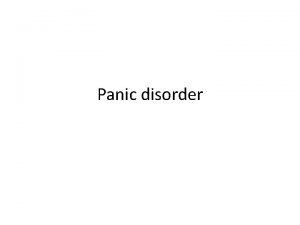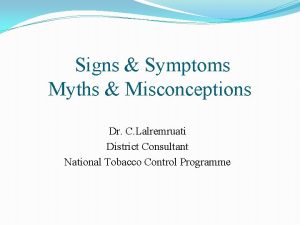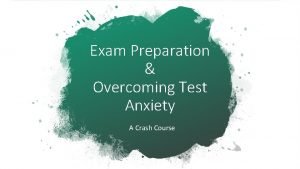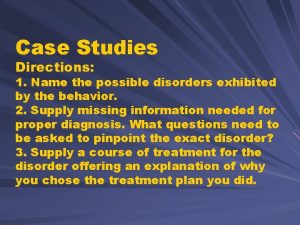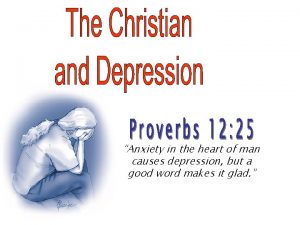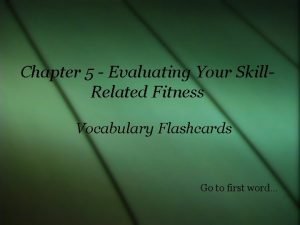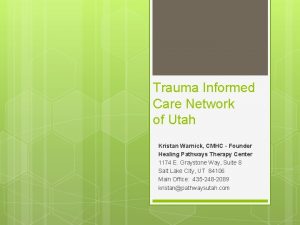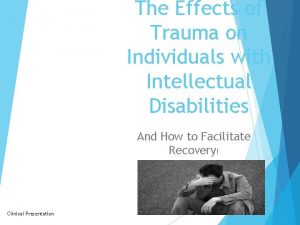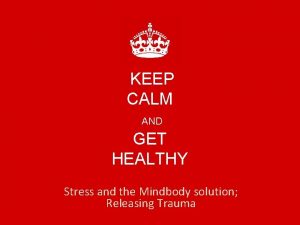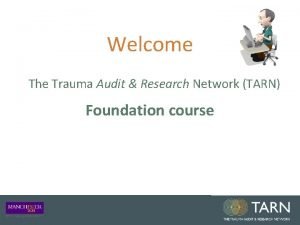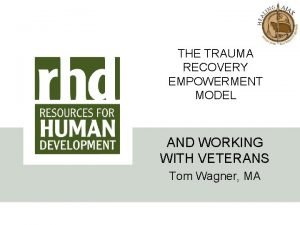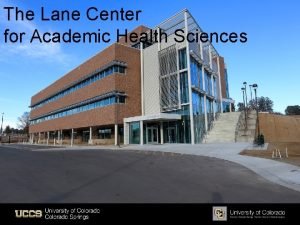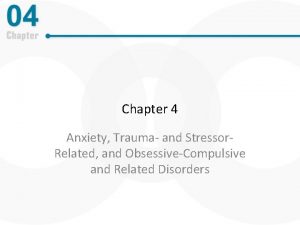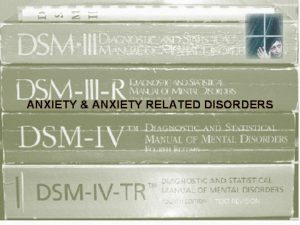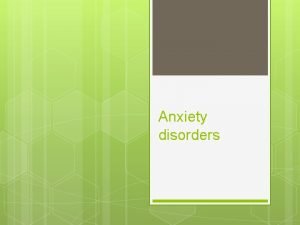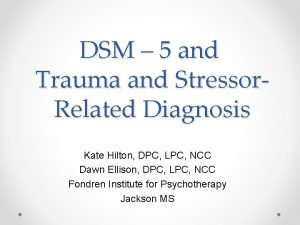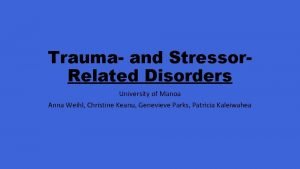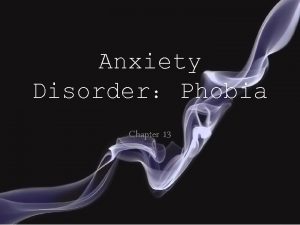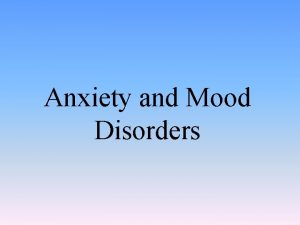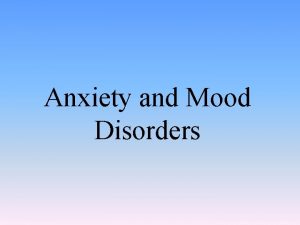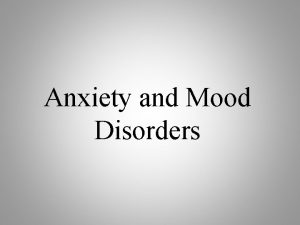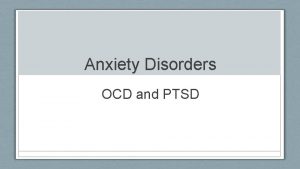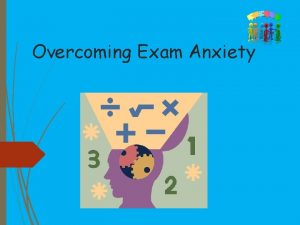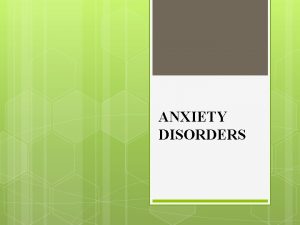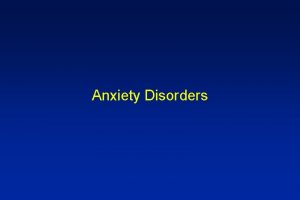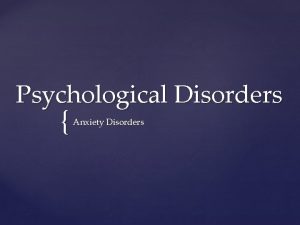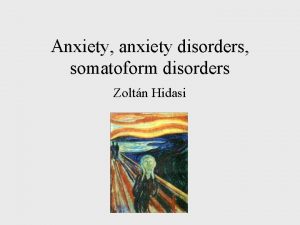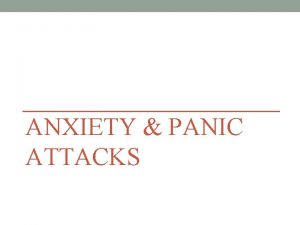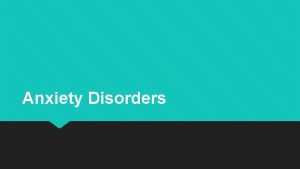Chapter 4 Anxiety Trauma and Stressor Related and



















































































- Slides: 83

Chapter 4 Anxiety, Trauma- and Stressor. Related and Obsessive-Compulsive and Related Disorders

Outline • Introduction to Anxiety • Anxiety Disorders – Generalized anxiety disorder – Panic Disorder and agoraphobia – Specific phobias – Social anxiety disorder • Trauma- and stressor-related disorders • Obsessive-Compulsive and Related Disorders

Focus Questions o How are anxiety, fear and panic unique? o What are the symptoms, causes and treatment options for anxiety disorders? o What are the symptoms, causes and treatment for trauma- and stressor-related disorders? o What are the symptoms, causes and treatment for obsessive-compulsive and related disorders?

The Complexity of Anxiety Disorders, Part 1 • Anxiety –a future-oriented mood state – Apprehension about future danger or misfortune – Physical symptoms of tension – Characterized by marked negative affect – May lead to avoidance of situations likely to provoke fear • Anxiety and fear are normal emotional states

The Complexity of Anxiety Disorders, Part 2 • Fear – a present-oriented mood state – Immediate fight or flight response to danger or threat – Involves abrupt activation of the sympathetic nervous system – Strong avoidance/escapist tendencies – Marked negative affect

From Normal to Disordered Anxiety and Fear • Characteristics of anxiety disorders – Pervasive and persistent symptoms of anxiety and fear – Involve excessive avoidance and escape – Cause clinically significant distress and impairment

The Phenomenology of Panic Attacks • Panic attack: abrupt experience of intense fear – Physical symptoms: heart palpitations, chest pain, dizziness, sweating, chills or heat sensations, etc. – Cognitive symptoms: Fear of losing control, dying, or going crazy • Two types – Expected – Unexpected

DSM Criteria: Panic Attack An abrupt surge of intense fear or intense discomfort that reaches a peak within minutes, and during which time four (or more) of the following symptoms occur: 1. Palpitations, pounding heart, or accelerated heart rate. 2. Sweating 3. Trembling or shaking 4. Sensations of shortness of breath or smothering 5. Feeling of choking 6. Chest pain or discomfort 7. Nausea or abdominal distress 8. Feeling dizzy, unsteady, lightheaded, or faint 9. Chills or heat sensations 10. Paresthesias (numbness or tingling sensations) 11. Derealization (feelings of unreality) or depersonalization 12. Fear of losing control or going crazy 13. Fear of dying From American Psychiatric Association. (2013). Diagnostic and statistical manual of mental disorders (5 th ed. ). Washington, DC.

Anxiety, Fear and Panic

Biological Contributions to Anxiety and Panic, Part 1 • Genetic vulnerability – More likely to be anxious if there is a family history of anxiety • Anxiety and brain circuits – Depleted levels of GABA are associated with more anxiety – Deficits in norepinephrine and serotonin also associated with greater anxiety

Biological Contributions to Anxiety and Panic, Part 2 • Limbic system and the septal-hippocampal systems • Behavioral inhibition system (BIS) • Fight/flight system (FFS)

Psychological Contributions, Part 1 – Early childhood - Experiences with uncontrollability and unpredictability lead to more anxiety – Stressful life events trigger vulnerabilities

Psychological Contributions, Part 2 • Behavioral and cognitive views – Invokes conditioning and cognitive explanations – Anxiety and fear are learned responses – Catastrophic thinking and appraisals play a role

An Integrated Model • Integrative view – triple vulnerability model – Generalized biological vulnerability – Generalized psychological vulnerability – Specific psychological vulnerability

Triple Vulnerability Model

Comorbidity • Comorbidity: Having more than one diagnosis at once – Common across the anxiety disorders – Major depression is the most common secondary diagnosis – About half of patients have two or more secondary diagnoses – Implications: • Common factors create and maintain disorders • A relation between anxiety and depression

Anxiety Disorders: An Overview • • Generalized anxiety disorder (GAD) Panic disorder (PD) Agoraphobia Social anxiety disorder (SAD) Specific phobias Selective mutism Separation anxiety disorder

Generalized Anxiety Disorder: Chronic Worry • Overview and defining features – Excessive uncontrollable anxious apprehension and worry about multiple areas of life (e. g. , work, relationships, health) – Persists for six months or more – Accompanied by associated symptoms (e. g. , muscle tension, restlessness, fatigue, irritability, concentration difficulties, sleep disturbance)

DSM-5 Criteria for GAD Features of GAD include the following: A. Excessive anxiety and worry (apprehensive expectation), occurring more days than not for at least six months about a number of events or activities (such as work or school performance). B. The individual finds it difficult to control the worry. C. The anxiety and worry are associated with at least three (or more) of the following symptoms (with at least some symptoms present for more days than not for the past 6 months) (Note: Only one item is required in children): 1. restlessness or feeling keyed up or on edge, 2. being easily fatigued, 3. difficulty concentrating on mind going blank, 4. irritability, 5. muscle tension, and/or 6. sleep disturbance. D. The anxiety, worry, or physical symptoms cause clinically significant distress or impairment in social, occupational, or other important areas of functioning. E. The disturbance is not due to the direct physiological effects of a substance (e. g. , a drug of abuse, a medication) or a general medical condition and is not better explained by another mental disorder. From American Psychiatric Association. (2013). Diagnostic and statistical manual of mental disorders (5 th ed. ). Washington, DC.

Generalized Anxiety Disorder, Part 1 • Statistics – Affects about 3. 1% of the general population – Females outnumber males approximately 2: 1 – Onset is often insidious, beginning in early adulthood – Very prevalent among the elderly – Tends to run in families

Generalized Anxiety Disorder, Part 2 • Associated features – Persons with GAD have been called “autonomic restrictors” – Less physiological response to stress than people with other anxiety disorders – Very sensitive to threat

Generalized Anxiety Disorder: Treatment • Treatment of GAD: Generally weak – Psychological interventions – cognitive-behavioral therapy – Pharmacotherapy • Benzodiazapines – often prescribed • Antidepressants – Meditation therapy – Combined treatments – acute vs. long-term outcomes

Integrative Model of GAD

Panic Disorder, Part 1 • Overview and defining features – Experience of unexpected panic attacks (i. e. , a false alarm) – Develop anxiety, worry, or fear about another attack – Many develop agoraphobia

DSM-5 Criteria for Panic Disorder Features of panic disorder include the following: A. Recurrent unexpected panic attacks are present. B. At least one of the attacks has been followed by 1 month of more of one or both of the following: a. persistent concern or worry about additional panic attacks or their consequences or b. A significant maladaptive change in behavior related to the attacks. C. The disturbance is not attributable to the physiological effects of a substance (e. g. , a drug of abuse, a medication) or another medical condition and is not better explained by another mental disorder. From American Psychiatric Association. (2013). Diagnostic and statistical manual of mental disorders (5 th ed. ). Washington, DC.

Panic Disorder and Agoraphobia - Agoraphobia = fear of being in places in which it would be difficult to escape or get help in the event of unpleasant physical symptoms (e. g. , panic attack, dizziness, vomiting, incontinence) - Panic and agoraphobia often occur together - Coupled together in previous editions of the DSM, e. g. , “Panic disorder with agoraphobia, ” “Agoraphobia without a history of panic disorder” - May occur independently

DSM-5 Criteria for Agoraphobia Features of agoraphobia include the following: A. Marked fear or anxiety about two or more of the following: public transportation, open spaces, enclosed places, standing in line or being in a crowd, being outside the home alone. B. The individual fears or avoids these situations due to thoughts that escape might be difficult or help might not be available in the event of developing panic-like symptoms or other incapacitating embarrassing symptoms. C. The agoraphobic situations almost always provoke fear or anxiety. D. The agoraphobic situations are actively avoided, require the presence of a companion, or are endured with intense fear or anxiety. E. The fear or anxiety is out of proportion to the actual danger posed by the agoraphobic situations, and to the sociocultural context. F. The fear, anxiety, or avoidance is persistent, typically lasting for 6 months or more. G. The fear, anxiety, or avoidance causes clinically significant distress or impairment in important areas of functioning. H. If another medical condition is present, the fear, anxiety, or avoidance is clearly excessive. I. The fear, anxiety, or avoidance is not better explained by the symptoms of another mental disorder. From American Psychiatric Association. (2013). Diagnostic and statistical manual of mental disorders (5 th ed. ). Washington, DC.

Panic Disorder, Part 2 • Facts and statistics – Affects about 2. 7% of the general population – Onset is often acute, mean onset between 20 and 24 years of age – 66% of individuals with agoraphobia are female • Cultural influences – Panic attacks interpreted differently across cultures

Isolated Sleep Paralysis in African. Americans with Panic Disorder

Risk Factors for Developing Panic Disorder • Generally higher emotional reactivity to stressors • Higher likelihood of having physical alarm reaction in response to stress • Tendency to believe that bodily sensations are dangerous or associated with catastrophic outcomes

Causes of Panic Disorder

Panic Disorder: Associated Features and Treatment • Associated features – Nocturnal panic attacks during non-REM sleep – Interoceptive avoidance • Medication treatment – SSRIs (e. g. , Prozac and Paxil) or benzodiazepines (e. g. , Ativan) – Relapse rates are high following medication discontinuation • Cognitive-behavioral therapy is highly effective

Panic Disorder: Treatment, Part 1 • Panic Control Treatment (PCT) – Example of CBT for panic – Cognitive therapy combined with purposefully triggering panic sensations to build tolerance • Psychological and combined treatments – Cognitive-behavioral therapies are highly effective – No evidence that combined treatment produces better outcome – Best long-term outcome is with cognitivebehavioral therapy alone

Panic Disorder: Treatment, Part 2

Specific Phobias: An Overview, Part 1 • Overview and defining features – Extreme irrational fear of a specific object or situation – Persons will go to great lengths to avoid phobic objects – Most recognize that the fear and avoidance are unreasonable – Markedly interferes with one’s ability to function

DSM-5 Criteria: Specific Phobias Features of specific phobia include the following: A. Marked fear or anxiety about a specific object or situation typically lasting for 6 months or more. B. The phobic object or situation almost always provokes immediate fear or anxiety and is avoided or endured with intense fear or anxiety. C. The fear or anxiety is out of proportion to the actual danger posed by the specific object or situation, and to the sociocultural context. D. The fear, anxiety, or avoidance causes clinically significant distress or impairment in social, occupational, or other important areas of functioning. E. The disturbance is not better explained by the symptoms of another mental disorder. From American Psychiatric Association. (2013). Diagnostic and statistical manual of mental disorders (5 th ed. ). Washington, DC.

Specific Phobias: An Overview, Part 2 • Facts and statistics – Females are again over-represented – Affects about 12. 5% of the general population – Phobias tend to run a chronic course

Specific Phobias: An Overview, Part 3 • Common specific phobias – Animals (e. g. , bees, dogs, snakes) – Natural environment (e. g. , heights, storms) – Situational (e. g. , flying, driving) – Blood-injection-injury: Blood draws, getting injections, seeing blood from a minor cut; watching others get blood drawn or injections • Sometimes associated with unusual vasovagal response > fainting

Phobia Development

Specific Phobias: Associated Features and Treatment • Causes of phobias – Direct experience – Biological and evolutionary vulnerability – Traumatic conditioning – Preparedness • Psychological treatments of specific phobias – Cognitive-behavior therapies are highly effective – exposure is critical • Cultural factors – certain objects feared more in different cultures

Social Anxiety Disorder: An Overview, Part 1 • Overview and defining features – Extreme fear or discomfort in social or performance situations – Markedly interferes with one’s ability to function – Often avoid social situations or endure them with great distress – Performance-only subtype: Anxiety only occurs in performance situations (e. g. , public speaking) without anxiety in everyday interactions

Social Anxiety Disorder: An Overview, Part 2 • Facts and statistics – Affects about 12. 1% of the general population, 6. 8% in 1 -year period – Prevalence is slightly greater in females than males – Second only to specific phobia in the anxiety disorders – Onset is usually during adolescence – Peak age of onset at about 13 years

DSM-5 Criteria for Social Anxiety Disorder Features of social anxiety disorder include the following: A. Marked fear or anxiety about one or more social situations in which the person is exposed to possible scrutiny by others, with the fear that one will act in a way, or show anxiety symptoms, that will be negatively evaluated. B. The social situations almost always provoke fear or anxiety and are avoided or endured with intense fear or anxiety C. The fear or anxiety is out of proportion to the actual threat posed by the social situation and to the sociocultural context. D. The fear, anxiety, or avoidance is persistent, typically lasting for 6 months or more and causes clinically significant distress or impairment in social, occupational, or other important areas of functioning. E. The fear, anxiety, or avoidance is not attributable to the effects of a substance or another medical condition and is not better explained by the symptoms of another mental disorder or condition. Specify if: Performance only: If the fear is restricted to speaking or performing in public. From American Psychiatric Association. (2013). Diagnostic and statistical manual of mental disorders (5 th ed. ). Washington, DC.

Social Phobia Development

Social Anxiety: Causes and Treatment • Causes – Biological and evolutionary vulnerability • Adaptive to fear rejection – Similar learning pathways as specific phobias • Psychological treatment – Cognitive-behavioral treatment (CBT) – Cognitive-behavioral group treatment (CBGT) – Cognitive-behavioral therapies are highly effective

Social Anxiety: Treatment • Medication treatment – Generalized social anxiety often treated with SSRIs – Circumscribed performance anxiety may be treated with beta blockers or benzodiazepines – Relapse rates are high following medication discontinuation

Selective Mutism (SM) – Rare childhood disorder characterized by a lack of speech – Must occur for more than one month and cannot be limited to the first month of school – High comorbidity with SAD – Treatment • CBT most efficacious, similar to treatment for SAD

Separation Anxiety Disorder – Characterized by unrealistic and persistent worry that something will happen to self or loved ones when apart (e. g. , kidnapping, accident) as well as anxiety about leaving loved ones – 4. 1% of children meet criteria, 6. 6% for adults

Trauma -and Stressor-Related Disorders • New classification in DSM-5 • Grouped together because of shared origin: stressful life events • Include PTSD and acute stress disorder, adjustment disorders and attachment disorders

Posttraumatic Stress Disorder (PTSD): An Overview, Part 1 • Overview and defining features – Main etiologic characteristics – trauma exposure and response – Reexperiencing (e. g. , memories, nightmares, flashbacks) – Avoidance – Emotional numbing and interpersonal problems – Markedly interferes with one's ability to function – PTSD diagnosed when reaction persists for one month or more

DSM-5 Criteria for PTSD, Part 1 Features of Posttraumatic Stress Disorder include the following: A. Exposure to actual or threatened death, serious injury, or sexual violation in one or more of the following ways: directly experiencing or witnessing the traumatic events; learning of a serious violent or accidental event occurring to a close relative or friend; or experiencing repeated or extreme exposure to aversive details of the traumatic event. (e. g. , first responders collecting human remains). B. Presence of one or more of the following intrusion symptoms associated with the traumatic event: 1. recurrent, involuntary, and intrusive distressing memories of the traumatic event, 2. recurrent distressing dreams related to the traumatic event, dissociative reactions (e. g. flashbacks) in which the individual feels or acts as if the traumatic event were recurring, or 4. marked psychological or physiological distress at exposure to internal or external reminders of the traumatic event. C. Persistent avoidance of stimuli associated with the traumatic even, beginning after the traumatic even occurred, as evidenced by one or both of the following: 1. Avoidance of or efforts to avoid distressing memories, thoughts, feelings, or conversations about or closely associated with the traumatic event, 2. avoidance of or effects to avoid external reminders that arouse distressing memories, thoughts, or feelings about or closely associated with the traumatic events, 3. inability to recall an important aspect of the trauma, 3. markedly diminished interest or participation in significant activities, feeling of detachment or estrangement from others, 6. restricted range of affect, or 7. sense of a foreshortened future.

DSM 5 Criteria for PTSD, Part 2 D. Negative alterations in cognitions and mood associated with the traumatic event, beginning or worsening after the traumatic event occurred, as evidenced by two or more of the following: 1. inability to remember an important aspect of the traumatic event, 2. persistent and exaggerated negative beliefs or expectations about oneself, others, or the world, 3. persistent distorted cognitions about the cause or consequences of the traumatic event that lead the individual to blame himself/herself or others, 4. persistent negative emotional state, 5. markedly diminished interest or participation in significant activities, 6. feelings of detachment or estrangement from others, or 7. persistent inability to experience positive emotions. E. Duration of the disturbance is more than one month and causes clinically significant distress or impairment in social, occupational, or other important areas of functioning. From American Psychiatric Association. (2013). Diagnostic and statistical manual of mental disorders (5 th ed. ). Washington, DC.

Posttraumatic Stress Disorder (PTSD): An Overview, Part 2 • Statistics – Combat and sexual assault are the most common traumas – Approximately 7% of people experience PTSD at in their lives, half of that in the past year – Lower than expected prevalence rates in trauma survivors (i. e. , many trauma survivors do not develop PTSD)

PTSD: Additional Terms • Acute – may be diagnosed one to three months post trauma • Chronic – diagnosed after three months post trauma • Delayed onset – onset six months or more post trauma • Acute stress disorder – PTSD immediately post -trauma (up to one month)

PTSD: Causes • Causes of PTSD – Intensity of the trauma and one's reaction to it (i. e. , true alarm, fear for one’s safety) – Learn alarms – direct conditioning and observational learning – Biological vulnerability – Uncontrollability and unpredictability – Social support post-trauma reduces risk

Causes of Post-Traumatic Stress Disorder

PTSD: Treatment, Part 1 • Psychological treatments – Cognitive-behavioral therapies (CBT) are highly effective – CBT may include: • graduated or massed (e. g. , flooding) imaginal exposure • develop narrative of traumatic event to process understanding • Challenge maladaptive beliefs about the world (e. g. , that interpersonal relationships are unsafe)

PTSD: Treatment, Part 2 • Medication – Generally use medications effective against anxiety and panic – Most common: SSRIs

Adjustment Disorders • Anxious or depressive reactions to life stress • Milder than PTSD/acute stress disorder • Occur in reaction to life stressors like moving, new job, divorce, etc • Clinically significant distress or impairment

Attachment Disorders • Disturbed and developmentally inappropriate behaviors in children • Child is unable or unwilling to form normal attachment relationships with caregiving adults • Occurs as a result of inadequate or neglectful care in early childhood

Reactive Attachment Disorder • Abnormally withdrawn and inhibited behavior • Less receptive to support from caregivers

Disinhibited Social Engagement Disorder • A pattern of abnormally low inhibition in children • E. g. , approaching unfamiliar adults without fear

Obsessive-Compulsive and Related Disorders • New Classification in DSM-5 • Grouped together because of shared features including obsessive thoughts and/or compulsive behaviors • Include OCD, hoarding disorder, body dysmorphic disorder, trichotillomania, excoriation

Obsessive-Compulsive Disorder (OCD): An Overview • Overview and defining features – Obsessions – intrusive and nonsensical thoughts, images, or urges – Compulsions – thoughts or actions to neutralize anxious thoughts – Vicious cycle of obsessions and compulsions – Cleaning and washing or checking rituals are common

Obsessive-Compulsive Disorder Summary Features of OCD include the following: A. Presence of obsessions, compulsions or both: – – Obsessions: Recurrent and persistent thoughts, urges, or images that are experienced, at some time during the disturbance, as intrusive and inappropriate and cause anxiety or distress; the individual attempts to ignore or suppress such thoughts, impulses, or images, or to neutralize them with some other thoughts or action. Compulsions: Repetitive behaviors (e. g. , counting, repeating words silently) that the individual feels driven to perform in response to an obsession, or according to rules that must be applied rigidly; the behaviors or mental acts are aimed at preventing or reducing distress or preventing some dreaded event or situation; however, these behaviors or mental acts either are not connected in a realistic way with what they are designed to neutralize or prevent or are clearly excessive. B. The obsessions or compulsions are time-consuming (e. g. take more than 1 hour per day) or cause clinically significant distress or impairment in important areas of functioning. C. The disturbance is not due to the direct physiological effects of a substance or another medical condition and is not better explained by the symptoms of another mental disorder. From American Psychiatric Association. (2013). Diagnostic and statistical manual of mental disorders (5 th ed. ). Washington, DC.

OCD: Causes and Associated Features, Part 1 • Statistics – Affects about 2% of the general population – Approximately equal gender distribution – Similar incidence and presentation across cultures – Onset is typically in early adolescence or young adulthood – OCD tends to be chronic

OCD: Causes and Associated Features, Part 2 • Causes of OCD – Parallels the other anxiety disorders – Early life experiences – Learning that some thoughts are dangerous/unacceptable – Thought-action fusion – the thought is similar to the action; thinking something will make it more likely to happen

Causes of Obsessive-Compulsive Disorder

OCD: Treatment, Part 1 • Biological treatment – Clomipramine and other SSRIs – benefit up to 60% of patients – Relapse is common with medication discontinuation – Psychosurgery (cingulotomy) is used in extreme cases

OCD: Treatment, Part 2 • Psychological treatment – Cognitive-behavioral therapy is most effective – CBT involves exposure to anxious cues and prevention of ritualized response • E. g. , touching door handles and not washing hands afterward • E. g. , saying blasphemous phrase and not engaging in ritualized prayer afterward – Combining CBT with medication – no better than CBT alone

Other OC & Related Disorders: Hoarding Disorder • Previously considered a type of OCD • Characterized by excessively collecting or keeping items regardless of their value and difficulty discarding items, usually due to a fear that one will need them later • Causes clinically significant distress or impairment (e. g. house too cluttered to live in, arguments with family members)

Trichotillomania (Hair Pulling Disorder) and Excoriation (Skin Picking Disorder) • Trichotillomania: The urge to pull out one’s own hair from anywhere on the body – Leads to noticeable hair loss on scalp, eyebrows, arms, pubic region, etc. • Excoriation: repetitive and compulsive picking of the skin, leading to tissue damage – 1 -5% prevalence rate • Behavioral habit reversal treatment is most effective treatment

Body Dysmorphic Disorder (BDD), Part 1 • A preoccupation with some imagined defect in appearance – E. g. , ears too big, muscles too small, skin uneven • Actual defect, if present, appears slight to others • Leads to clinically significant distress/impairment • Often leads to compulsive behaviors (e. g. , repeated mirror checking)

DSM – 5 Body Dysmorphic Disorder (BDD) Features of BDD include the following: A. Preoccupation with one or more defects or flaws in physical appearance that are not observable or appear slight to others. B. Repetitive behaviors (e. g. , mirror checking) or mental acts (e. g. comparing his or her appearance with that of others) in response to the appearance concerns. C. The preoccupation causes clinically significant distress or impairment in important areas of functioning. D. The appearance preoccupation is not better explained by concerns with body fat or weight in an individual whose symptoms meet diagnostic criteria for an eating disorder. From American Psychiatric Association. (2013). Diagnostic and statistical manual of mental disorders (5 th ed. ). Washington, DC.

Body Dysmorphic Disorder (BDD), Part 2 • Statistics – More far common than previously thought – 1 -2% of general population – 4% to 28% of college students meet the criteria for this disorder at some point – Seen equally in males and females – Many remain single, and many seek out plastic surgeons – Usually runs a lifelong chronic course

Body Dysmorphic Disorder: Causes • Causes – Little is known – disorder tends to run in families – Shares similarities with obsessive-compulsive disorder

Body Dysmorphic Disorder: Treatment • Treatment parallels that for OCD – Cognitive behavioral therapy – Exposure to anxiety (e. g. , not wearing makeup) & preventing compulsions (e. g. , no mirror available) • Medications (i. e. , SSRIs) that work for OCD provide some relief • Cultural example – Taijin Kyofusho

Plastic Surgery • Study of BDD patients: 76. 4% had sought this type of treatment and 66% were receiving it • 8% to 25% of all patients who request plastic surgery may have BDD • May worsen condition, unlikely to help

Summary, Part 1 • Anxiety and related disorders occur when natural and adaptive processes (anxiety, fear and panic) become disproportionate to the environment • These disorders occur as a result of generalized biological vulnerabilities, generalized psychological vulnerabilities, and specific psychological vulnerabilities

Summary, Part 2 • Anxiety disorders include: – Panic disorder – Agoraphobia – Generalized anxiety disorder – Social anxiety disorder – Specific phobia – Selective mutism – Separation anxiety disorder

Summary, Part 3 • Trauma- and stressor-related disorders share a common etiology: stressful experiences. • Trauma- and stressor-related disorders include: – PTSD – Acute stress disorder – Adjustment disorders – Reactive attachment disorder – Disinhibited social engagement disorder

Summary, Part 4 • Obsessive-compulsive and related disorders share common features: compulsive behaviors and, sometimes, obsessive thoughts • Obsessive-compulsive and related disorders include: – OCD – Hoarding disorder – Trichotillomania – Excoriation – Body dysmorphic disorder

Summary, Part 5 • The most effective treatment for most anxiety disorders is cognitive behavioral therapy • Medications may also be helpful in treating anxiety disorders
 Nursing diagnosis ineffective coping related to anxiety
Nursing diagnosis ineffective coping related to anxiety Types of stressor
Types of stressor Ambient stressor
Ambient stressor Two types of fitness
Two types of fitness What is skill-related fitness? *
What is skill-related fitness? * Chapter 8 managing stress and anxiety
Chapter 8 managing stress and anxiety Chapter 15 anxiety and obsessive-compulsive disorders
Chapter 15 anxiety and obsessive-compulsive disorders Chapter 5 lesson 1 dealing with anxiety and depression
Chapter 5 lesson 1 dealing with anxiety and depression Chapter 5 lesson 1 dealing with anxiety and depression
Chapter 5 lesson 1 dealing with anxiety and depression Chapter 18 managing anxiety
Chapter 18 managing anxiety A 23 year old male experienced severe head trauma
A 23 year old male experienced severe head trauma Frustration anxiety and tension
Frustration anxiety and tension What is rational detachment
What is rational detachment Anxiety symptoms
Anxiety symptoms Chapter 16 worksheet the knee and related structures
Chapter 16 worksheet the knee and related structures Chapter 16 worksheet the knee and related structures
Chapter 16 worksheet the knee and related structures Chapter 4 income statement and related information
Chapter 4 income statement and related information How anxiety affects eyewitness testimony
How anxiety affects eyewitness testimony Relaxation techniques test anxiety
Relaxation techniques test anxiety Exam anxiety symptoms
Exam anxiety symptoms I'm a perfect example of someone who has math anxiety
I'm a perfect example of someone who has math anxiety Neurotic behavior
Neurotic behavior Anxiety mnemonic
Anxiety mnemonic Examples of generalized anxiety disorder
Examples of generalized anxiety disorder Neurotic anxiety example
Neurotic anxiety example Ego syntonic vs dystonic
Ego syntonic vs dystonic Uw integrative medicine
Uw integrative medicine Astrid zamora
Astrid zamora Tetrafol plus for anxiety
Tetrafol plus for anxiety Generalized anxiety disorder dsm 5
Generalized anxiety disorder dsm 5 Define neurotic
Define neurotic Neurotic anxiety example
Neurotic anxiety example Source-oriented charting
Source-oriented charting Test anxiety essay
Test anxiety essay Caregiver anxiety
Caregiver anxiety Dr fayad
Dr fayad School anxiety symptoms
School anxiety symptoms Ocd behaviors
Ocd behaviors Moderate anxiety symptoms
Moderate anxiety symptoms Yadasentience
Yadasentience Anxiety disorders def
Anxiety disorders def Examples of generalized anxiety disorder
Examples of generalized anxiety disorder Agoraphobia vs social anxiety
Agoraphobia vs social anxiety Peter de maria
Peter de maria Explanation of anxiety disorder
Explanation of anxiety disorder Explanation of anxiety disorder
Explanation of anxiety disorder Stai adalah
Stai adalah Status anxiety
Status anxiety Obsessive compulsive disorder
Obsessive compulsive disorder Anxiety explanation
Anxiety explanation Prayer before writing an exam
Prayer before writing an exam Warning signs of anxiety
Warning signs of anxiety Anxiety explanation
Anxiety explanation Panic cycle clark
Panic cycle clark Hydroxyzine pam 50 mg cap for anxiety
Hydroxyzine pam 50 mg cap for anxiety Mr fisc anxiety
Mr fisc anxiety Anxiety explanation
Anxiety explanation Children who release unexpressed anger
Children who release unexpressed anger Multipath model of anxiety disorders
Multipath model of anxiety disorders Anxiety lan chhuah dan
Anxiety lan chhuah dan Stress anxiety depression
Stress anxiety depression Separation anxiety test
Separation anxiety test Anxiety meaning
Anxiety meaning Anxiety decision tree
Anxiety decision tree Examples of directional hypothesis
Examples of directional hypothesis Severe anxiety
Severe anxiety Hamilton anxiety rating scale
Hamilton anxiety rating scale Tips anxiety
Tips anxiety Anxiety headache
Anxiety headache What is anxiety examples
What is anxiety examples Oedipus complex
Oedipus complex Anxiety attack
Anxiety attack Teenagers anxiety friend
Teenagers anxiety friend Palpitation
Palpitation Crash course test anxiety
Crash course test anxiety Sadie is so fearful of being overwhelmed
Sadie is so fearful of being overwhelmed Anxiety in the heart of man causes depression
Anxiety in the heart of man causes depression Chapter 5 skill related fitness crossword
Chapter 5 skill related fitness crossword Trauma awareness and treatment center utah
Trauma awareness and treatment center utah Triune brain theory and trauma
Triune brain theory and trauma I was not aware
I was not aware Trauma audit and research network
Trauma audit and research network Trauma recovery and empowerment model
Trauma recovery and empowerment model Uccs health circle primary care clinic
Uccs health circle primary care clinic

